Stella Park
14 11 18 12:15 Filed in: Young Adults 1970s
Guelda and Polly Pyke were Jono’s father’s first cousins; and were always very much part of Jono's and his sister Anne's life.
Polly was the eldest and an eccentric character with a dry quick wit. Her sister Guelda, also eccentric, was an artist and part of the vibrant Melbourne art scene in the late 40’s and 50’s.
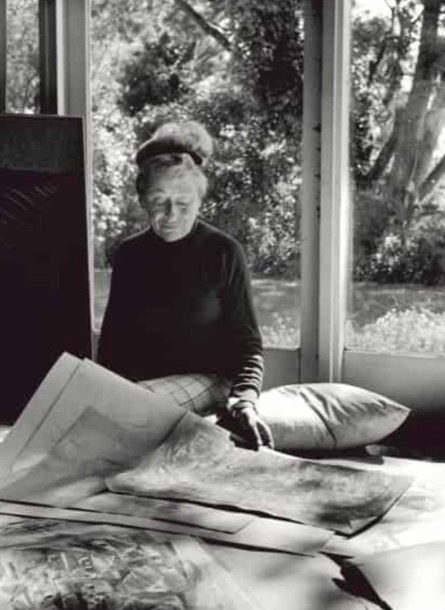
Guelda in her studio
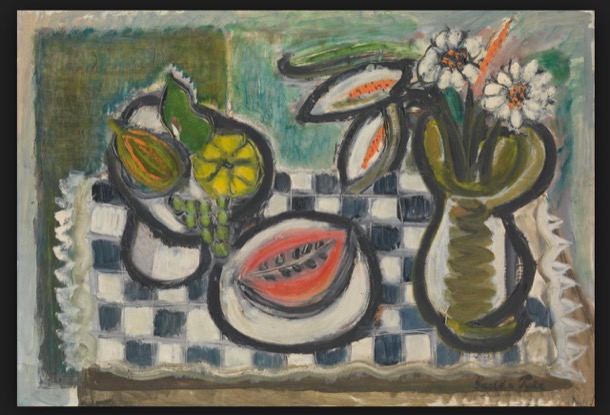
A still life by Guelda
At this time Melbourne was awash with new modernist ideas in the arts and architecture. Guelda was taught by George Bell, one of the early modernist painters. In these classes she mixed with other influential young painters of the day, some of whom remained lifelong friends. It was likely that through this group Guelda met Alistair Knox, an emerging young architect, who the sisters commissioned to design their house at Templestowe.
Polly and Guelda with two other friends, also sisters, bought a working apple and peach orchard in Templestowe. Stella Park, as it was called, was named after the orchardists’s wife.They were not alone in moving to the outer suburbs, as the area was becoming a favourite with many young artists. John and Sunday Reid had already established their retreat at Heide, where they nurtured a circle of artists, writers and intellectuals. Heidi had become a place for the discussion, creation and promotion of modern art and literature. Alistair Knox was also working in the area, known especially for his mud brick houses.
The RMIT Design Archives have in Knox’s words a description of the project at Stella Park.
Knox reminisces:
One day in 1948 I was approached by an executive of the Art Gallery of Victoria on behalf of four ladies who proposed to build three houses on a twenty-acre peach and apple orchard in Templestowe - a joint house for Polly and Guelda Pyke, and separate ones for Val and Yvonne Cohen. They were all unmarried at this stage, although Val was anticipating marriage in the near future and her mother proposed to live with Val's sister Yvonne in the second house. As the Pykes' was a joint building, the two women decided to occupy separate sections of the building, especially as Guelda required a private area for her work as a practising artist. They had independent means, and this gave me my first opportunity to produce three sizeable houses amid the pink and white plum blossoms that covered the northern slope and looked over the river towards Eltham. It was an idyllic scene, particularly as these would be almost the first houses that could be seen from that direction. This was before any orchards had been subdivided, and the unbroken pattern of fruit trees separated by lines of ancient pines had remained unaltered since the land was first settled by a largely German community a hundred years earlier.
I had opted for timber construction on concrete slabs because there was a slight improvement in the supply position and because I thought earth-building would prove too great a strain on my elegant artistic lady clients, no matter how they thought about it before it all began.
https://alistairknox.org/buildings/64

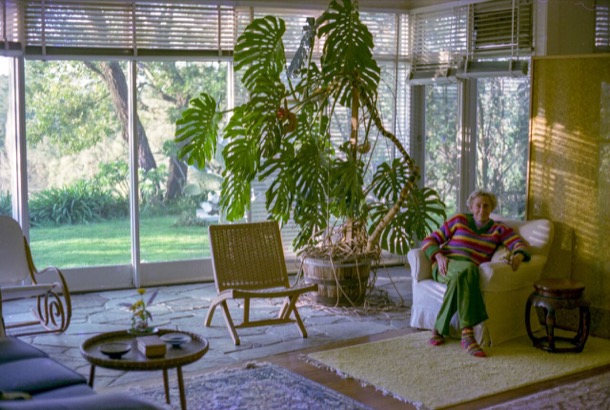
Polly in her lounge room (Photo by Fred)
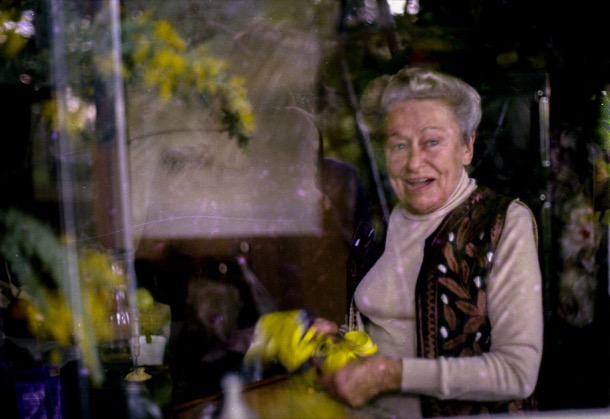
Guelda in her kitchen (Photo by Fred)
Stella Park was very much part of Jono’s childhood. Below he has recorded his memories of that special place.
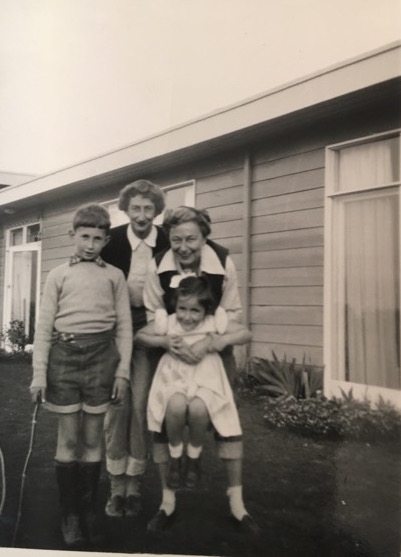
Left to right: Jono, Polly, Guelda, Anne, in the garden soon after the house was built.
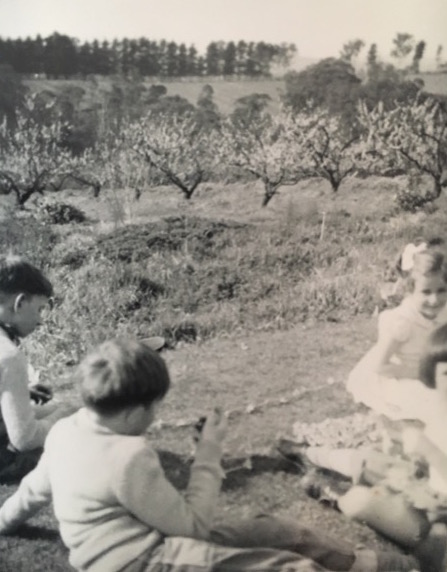
Anne, Jono and friends in the orchard.
Anna and Thomas and I were also lucky to have experienced visits to Polly and Guelda at Templestowe. We too loved sitting on the floor at Guelda’s end eating hot chutney, Guelda bread and other assorted goodies, exploring the house and garden and walking to the Yarra.

Anna, Thomas and friends
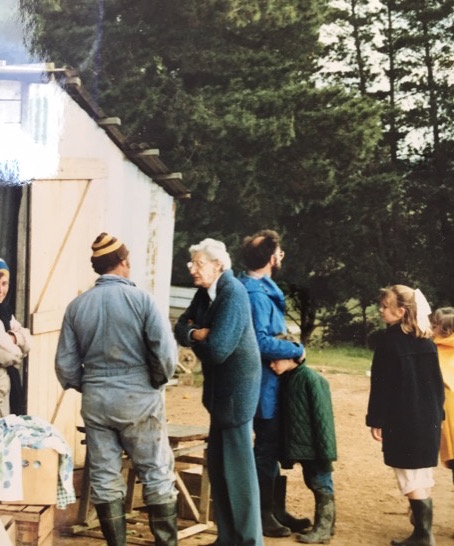
Left to right: Pasquale, local vegetable grower, Polly, Jono, Thomas and friend
Stella Park was an ambitious enterprise for four very adventurous women. Polly and Guelda both loved their part of it. They lived there until in their eighties they could no longer look after the property. We were lucky to have have known it.
Polly was the eldest and an eccentric character with a dry quick wit. Her sister Guelda, also eccentric, was an artist and part of the vibrant Melbourne art scene in the late 40’s and 50’s.

Guelda in her studio

A still life by Guelda
At this time Melbourne was awash with new modernist ideas in the arts and architecture. Guelda was taught by George Bell, one of the early modernist painters. In these classes she mixed with other influential young painters of the day, some of whom remained lifelong friends. It was likely that through this group Guelda met Alistair Knox, an emerging young architect, who the sisters commissioned to design their house at Templestowe.
Polly and Guelda with two other friends, also sisters, bought a working apple and peach orchard in Templestowe. Stella Park, as it was called, was named after the orchardists’s wife.They were not alone in moving to the outer suburbs, as the area was becoming a favourite with many young artists. John and Sunday Reid had already established their retreat at Heide, where they nurtured a circle of artists, writers and intellectuals. Heidi had become a place for the discussion, creation and promotion of modern art and literature. Alistair Knox was also working in the area, known especially for his mud brick houses.
The RMIT Design Archives have in Knox’s words a description of the project at Stella Park.
Knox reminisces:
One day in 1948 I was approached by an executive of the Art Gallery of Victoria on behalf of four ladies who proposed to build three houses on a twenty-acre peach and apple orchard in Templestowe - a joint house for Polly and Guelda Pyke, and separate ones for Val and Yvonne Cohen. They were all unmarried at this stage, although Val was anticipating marriage in the near future and her mother proposed to live with Val's sister Yvonne in the second house. As the Pykes' was a joint building, the two women decided to occupy separate sections of the building, especially as Guelda required a private area for her work as a practising artist. They had independent means, and this gave me my first opportunity to produce three sizeable houses amid the pink and white plum blossoms that covered the northern slope and looked over the river towards Eltham. It was an idyllic scene, particularly as these would be almost the first houses that could be seen from that direction. This was before any orchards had been subdivided, and the unbroken pattern of fruit trees separated by lines of ancient pines had remained unaltered since the land was first settled by a largely German community a hundred years earlier.
I had opted for timber construction on concrete slabs because there was a slight improvement in the supply position and because I thought earth-building would prove too great a strain on my elegant artistic lady clients, no matter how they thought about it before it all began.
https://alistairknox.org/buildings/64


Polly in her lounge room (Photo by Fred)

Guelda in her kitchen (Photo by Fred)
Stella Park was very much part of Jono’s childhood. Below he has recorded his memories of that special place.

Left to right: Jono, Polly, Guelda, Anne, in the garden soon after the house was built.

Anne, Jono and friends in the orchard.
Anna and Thomas and I were also lucky to have experienced visits to Polly and Guelda at Templestowe. We too loved sitting on the floor at Guelda’s end eating hot chutney, Guelda bread and other assorted goodies, exploring the house and garden and walking to the Yarra.

Anna, Thomas and friends

Left to right: Pasquale, local vegetable grower, Polly, Jono, Thomas and friend
Stella Park was an ambitious enterprise for four very adventurous women. Polly and Guelda both loved their part of it. They lived there until in their eighties they could no longer look after the property. We were lucky to have have known it.
blog comments powered by Disqus
